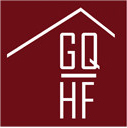Landmarks
The Carriage House
The Carriage House Building
401 G Street
Architect Unknown
On December 23,1869, John D. Backesto purchased lots A -L of Block 95/88 from Alonzo Horton for $300.00. Although Dr. Backesto was from San Jose, California, he was very active in the ever-expanding real estate market in San Diego. He is perhaps best known for the formidable Backesto Building located at 5th and H Streets (now Market St.), the heart of the business district in early San Diego.
The Sanborn Fire Map of 1883 shows no structure on the property, but by 1887, three frame buildings occupied the space. These buildings, also property of Dr. Backesto, were formerly located at 5th and H Streets, the site of Dr. Backesto’s iconic structure. Through the ensuing five years, a carpenter shop, sign painters, a mortuary and the Daily San Diegan , a newspaper, were listed as building occupants in the city directory. The Daily San Diegan offered an opposing view to the Republican philosophy of the San Diego Union. Although the Union welcomed its new competition, the fortunes of the fledgling newspaper took a turn for the worse when San Diego’s economic boom of the 1880s started to wane in the latter part of the era. By 1889, the Daily San Diegan was sold and consequently absorbed by the San Diego Sun
By 1890, a new building had risen at the site, the southeast corner of 4th and G Streets. It displaced the mortuary and Captain Lovedall’s ship chandlery, and now housed Todd and Harley, a hardware firm. Dr. Backesto died that year and the entirety of the property went to his wife, Anna Backesto. His nephew, George W. Hazzard, managed the property. Harley and Todd remained at the location until 1902. George Hazzard, an enterprising and hard- working young man, became a highly successful businessman, and later bought the property from the estate of Anna Backesto after her death in 1920.
In November of 1902, Todd and Harley were bought out by Daniel W. Lyons and Newell Mathews, who renamed the business the Lyons Implement Company. The new firm carried a complete line of Studebaker vehicles, including buggies and large wagons. The enlarged doors which allowed the vehicles to be put in and later taken out of the building are still in effect today. When automobiles were introduced to San Diego, the firm carried Studebaker autos. The firm remained at the site until after 1930.

During the 1920s, part of the property, which had been sub-divided by Hazzard, also housed the San Diego Farm and Dairy Supply, the San Diego Electric Company, and the San Diego Tent and Awning Company. Hazzard sold the sub-divided section to John Engebretsen, a successful contractor, responsible for part of the work at North Island Naval Station, the San Diego Marine Base and for the paving of nearly all the streets in Coronado. Engebretsen, a Norwegian immigrant, was appointed deputy consul for Norway and Sweden in 1896, and eventually commissioned vice-consul by Secretary of State, John Hay. King Haakon VII of Norway later knighted Engretsen in the Order of St Olaf and decorated him with the Cross of St. Olaf, the highest honor in the kingdom of Sweden. John Engretsen died in 1936 and the Hazzard family regained possession of the property in total when his widow passed in 1938. When George Hazzard passed in 1942, his son, Henry Hazzard became heir to the property.
Henry Hazzard, one year later, sold the property to Eliza Fitzgerald Walker, president of the Walker Scott department store chain. The Walker Scott Corporation used the property as a warehouse and storage facility until 1955, when they vested ownership to the Volunteers of America. After an extensive remodeling, the Volunteers opened the building as a thrift store, offices, workshops and a nondenominational religious and welfare agency.
The building, which is essentially the same building built by John Backesto in 1890, now houses Tin Roof, a bar and music venue and The Shout! House, a popular live music and karaoke establishment.
Sandee Wilhoit is the historian for the Gaslamp Quarter Historical Foundation. She can be reached at [email protected].

